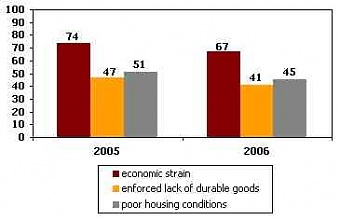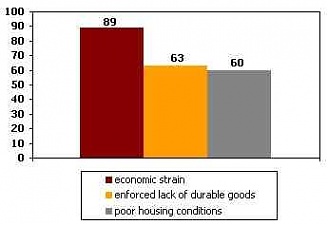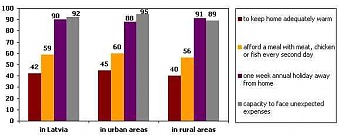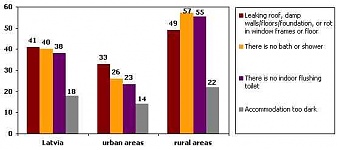Analytics, Latvia, Quality of life
International Internet Magazine. Baltic States news & analytics
Wednesday, 10.12.2025, 16:51
EU-SILC 2006: on indicators characterising material deprivation in Latvia
 Print version
Print versionBut it is necessary to recognize that, income even above poverty risk threshold not always ensure the inhabitants with the “decent” living standard. This press release examines such statistically modestly researched phenomenon as material deprivation, what is considered as conditions emerging from the lack of the economical resources and interdicts the access to material goods, as well as, is characterised with poor housing conditions and enforced lack of (because of the lack of money) durable goods.
Within the framework of the survey, following dimensions of the material deprivation were studied:
- economic straint;
- enforced lack of durable goods;
- poor housing conditions.
The data of the survey of 2006 show that, material deprivation is more common than a risk of poverty. But to compare the data of the survey of 2006 with the data of 2005, it can be concluded that, the risk of material deprivation has a trend to decrease, what can bee seen in the following graph.
 |
|---|
| Subjection of households to different factors of material deprivation risk in 2005 and 2006 (in %) |
 |
|---|
| Subjection of households to different factors of material deprivation risk in the poor households in 2006 (in %) |
Indisputably that, mostly the poor households are influenced by the burden of material deprivation.
The most important factor of the material deprivation risk is economic strain. The economic strain is determined with several questions of EU-SILC questionnaire, in which the respondents were asked to evaluate the household’s could afford (if wanted to) to cover fallowing expenses:
- meal with meat, chicken or fish every second day;
- one week annual holiday away from home;
- capacity to face unexpected expenses of 75 lats from your resources within one month;
- to keep home adequately warm;
- arrears (mortgage or rent, utility bills or hire purchase installments).
Households, that answered negatively to al least two questions, were considered to be dependent on economic strain. According to EU-SILC data of 2006, 65% of households in cities and 72% in rural areas depended on it.
In households, income of which were under the poverty risk threshold (the poorest households), the rate of economic strain reached 89%, if compared to 67% on average in the country. In the context of economic strain the dominating factors in these households can bee seen in following graph.
 |
|---|
| Share of poor households in 2006, which due to the lack of money could not afford following expenses (as % of the total number of poor households) |
Describing enforced lack of durable goods in EU-SILC, questions about ability of households to afford usage of such durable and household commodities as telephone, colour TV set, washing machine and car were used. The share of poor households, which due to the lack of money in their households could not afford one of those durable goods, were 62% in urban areas and 63% in rural areas, but excluding the car from the list – 35% and 33%, respectively. Because of the same reason, 16% of the poor households were not able to afford telephone (including mobile telephone), and 8% of the households could not afford colour TV set.
More significant problems to the households arise from the poor housing conditions. 45% of households in Latvia depend on this risk. This risk is noticeably higher among the poor households and reaches 60%. The aspects of poor housing conditions in the EU-SILC were found out with the help of following questions:
- leaking roof, damp walls/floors/foundations, or rot in window frames or floor;
- accommodation too dark, not enough light;
- no bath or shower in dwelling;
- no in door flushing toilet (WC) for sole use of the household.
It is considered that, household is exposed to poor household condition material deprivation risk, if in it at least one of mentioned housing quality problems occur. According to the data of the EU-SILC, the residents of rural areas more often have objective reasons to be unsatisfied with their dwelling. Almost three fourths (74%) of the poor households residing the rural areas mentioned one of the listed circumstances of poor housing conditions (in poor households in urban areas – 48%).
 |
|---|
| Share of selected poor housing conditions in poor households in 2006 (in %) |
It has been envisaged to include more questions characterising the aspects of material deprivation in the EU-SILC 2009, as well as, on the material deprivation of the children. This information will be available for the data users.
_________________________________
1 In all Member States of the European Union, according to the methodology of the Laeken indicators 60% of the equivalent disposable income median are assumed as at risk of poverty threshold. It is calculated dividing the value of disposable income with the number of equivalent adults in the households. But arranging all household income per equivalent consumer in ascending order from the lowest to highest, the median(value located in the middle) is set in the middle of their arrangement, 60% of which forms the at risk of poverty threshold. Each year this threshold is calculated again.
2 In the Community Statistics on Income and Living Conditions (EU-SILC) survey of 2006 totally 4315 households were surveyed.
3 The value of at risk of poverty rate is calculated in relation to the household composition: LVL 88 per month for the single person household, for the household consisting of 2 adults and 2 dependent children – LVL 185 per month.








 «The Baltic Course» Is Sold and Stays in Business!
«The Baltic Course» Is Sold and Stays in Business!

